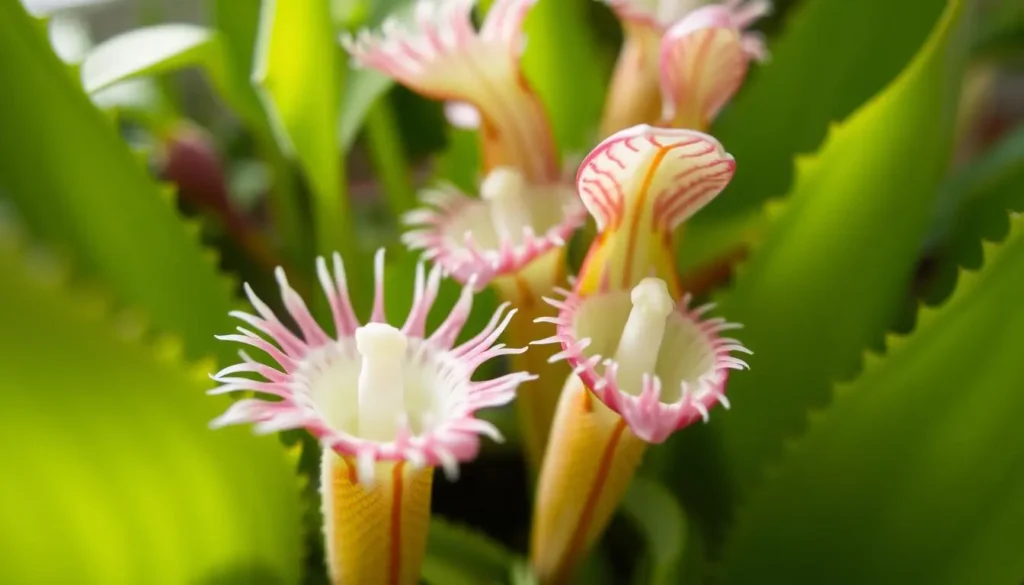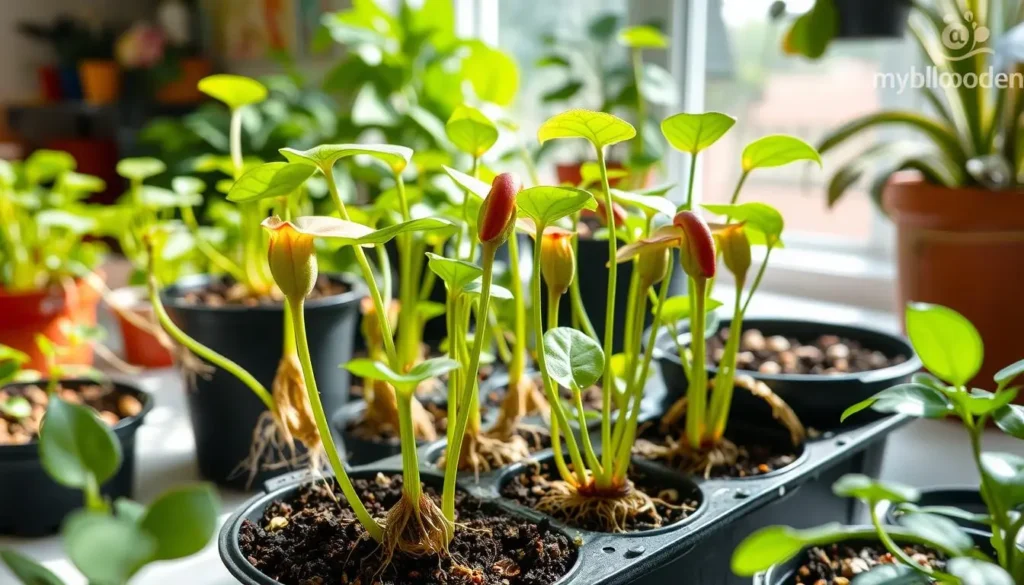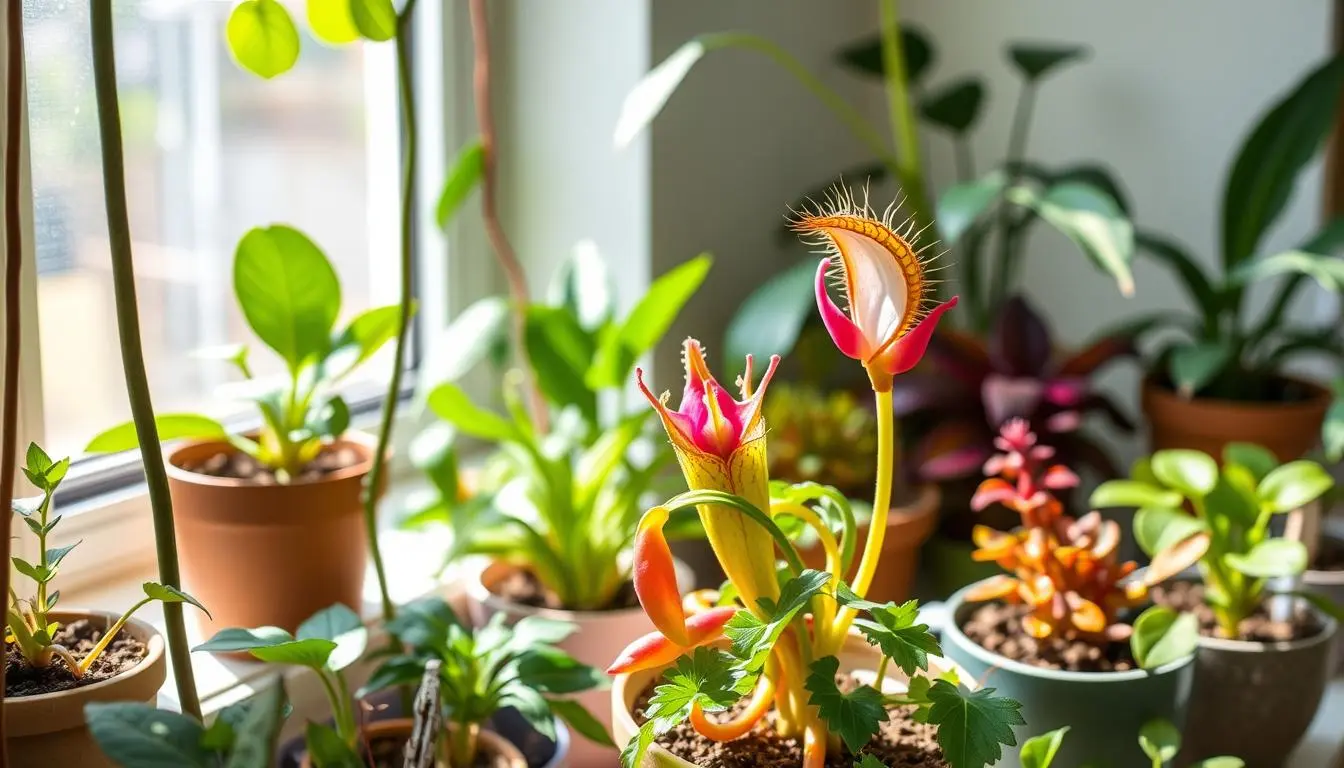Imagine walking into your home and seeing a unique houseplant. It’s not just any plant; it’s a Venus fly trap. This plant captures and eats insects, making it more than just pretty. It changes how you think about taking care of plants, blending beauty with usefulness.
My first time seeing a Venus-fly trap was amazing. Watching it catch a fly was like magic. It made me feel like a piece of nature was in my living room. This plant is special, offering a fun and useful way to garden indoors.
Table of Contents
Unique and Attractive Appearance
The Venus fly trap is a great choice for an attractive houseplant. It stands out with its unique look and bright colors. It’s perfect for adding something special to your indoor garden.
Distinctive Traps
The Venus fly trap’s traps are truly fascinating. They look like jaws and are both beautiful and functional. Each trap has two lobes with hair-like parts that snap shut when an insect gets caught.
This amazing feature makes your plant collection even more interesting. It’s one of the most unique venus-fly trap characteristics out there.
Color Variations
Venus-fly traps come in a variety of colors, from bright green to deep red. The color changes based on sunlight and the plant’s type. Some have a striking red inside that contrasts with the green outside.
This makes them even more eye-catching as an attractive houseplant. The colors help attract insects, which is part of their natural defense.
Natural Pest Control
Adding a Venus-fly trap to your indoor garden is a smart move for natural pest control. These plants are great at catching unwanted insects. They use their special traps to feed themselves and keep your home pest-free.
Insect Trapping Mechanism
The Venus-fly trap’s insect trapping mechanism is fascinating. Its leaves have tiny trigger hairs. When an insect touches these hairs, the trap closes, catching the bug.
This natural trap is not only amazing but also very good at reducing household pests.
Having a Venus-fly trap in your home can really cut down on pests. These plants eat insects, which helps them grow. This helps keep your home comfortable and bug-free.
Reducing Household Pests
Low Maintenance Requirements
The Venus-fly trap is known for being easy to care for. It’s great for anyone who wants a unique plant without a lot of work.
How to Water Venus Fly Trap
It’s important to know how much to water a Venus fly trap. This plant likes distilled or rainwater better than tap water. Tap water can have minerals that harm it. Make sure the soil is moist but not too wet by adding water as needed.
Minimal Feeding Needs
The Venus-fly trap needs very little food. It catches a few insects a month to survive. Don’t feed it too much, as this can cause it to grow poorly.
Easy to Handle
Taking care of a Venus fly trap is simple. It’s perfect for beginners. This plant doesn’t need a lot of fertilizing or complicated care, making gardening easier.
Educational Value for Children
Adding a Venus-fly trap to your indoor garden can be a great learning experience for kids. As an educational houseplant, it fascinates young minds with its ability to trap and digest insects. This unique feature makes it a great subject for kids to study, encouraging them to learn about plant biology hands-on.
Here are some educational benefits of having a Venus-fly trap:
- Observation of a unique insect trapping mechanism.
- Understanding the plant lifecycle from growth to dormancy.
- Practicing plant care by maintaining the appropriate environment for the Venus fly trap.
This educational houseplant lets kids see science in action. It makes the Venus fly trap a valuable learning experience.
Caring for a Venus fly trap also teaches kids responsibility and how to nurture living things. For these reasons, a Venus fly trap for kids is a great addition to any indoor garden. It teaches kids both practical skills and botanical knowledge.
Conversation Starter
Looking for a houseplant that starts conversations? The Venus-fly trap is perfect. It’s not just a cool plant for your home. It’s also a great way to spark interesting talks.
The Venus-fly trap is special because it eats insects. Its leaves snap shut to trap prey, unlike most plants. Talking about this with guests can lead to fun discussions about plants and nature.
This plant’s look is both mysterious and eye-catching. Its bright colors and unique shape grab everyone’s attention. It’s not just a decoration. It also teaches and entertains your visitors.
Potential to Bloom
Venus fly traps are known for their unique ability to capture insects and their beauty when they bloom. With proper care, these plants can show off lovely white flowers. This adds a new layer of beauty to their already fascinating presence.
Venus Fly Trap Flowering
With the right conditions, your venus-fly trap might bloom in spring or early summer. The venus fly trap flowers are white with delicate petals. They stand tall to avoid trapping pollinators. To see your flowering venus fly trap at its best, make sure it gets enough light, has the right humidity, and has good soil.

How to Care for Venus Fly Trap in Winter
Proper venus-fly trap winter care is key to keeping it healthy and ready to bloom again. In winter, these plants slow down and stop trapping insects. Here’s how to care for your venus-fly trap during this time:
- Keep it cool, between 35-50°F (1-10°C).
- Water it less, but keep the soil moist.
- Don’t feed it during this time.
- Give it indirect light to mimic shorter days.
By paying attention to venus-fly trap winter care and adjusting its environment, your plant will thrive. It will remain a captivating part of your indoor garden all year.
Compact Size for Small Spaces
The Venus fly trap is perfect for small spaces. These plants are not only interesting to look at but also easy to care for because of their size.
Fully Grown Venus Fly Trap
A fully grown Venus fly trap is about five inches wide. Each trap can grow up to 1.5 inches. They are great for small areas like dorm rooms or office desks. Despite their size, they are both beautiful and useful.
Smallest Venus Fly Trap Varieties
There are Venus-fly traps that are even smaller. These tiny plants are under three inches wide. They still catch insects and look vibrant, but they fit in tiny spaces.
Variety of Species
The Venus-fly trap is known for its unique look and how it catches insects. There are many types to choose from. This guide will help you pick the right one for your indoor garden.
Types of Venus Fly Traps
Exploring the types of venus-fly traps reveals many unique varieties. The most common is the Dionaea muscipula, known for its big traps and bright colors. Other favorites include:
- ‘Akai Ryu’ – Known for its bright red leaves and traps.
- ‘B52’ – Famous for its huge traps.
- ‘Sawtooth’ – Has jagged edges on its traps.
- ‘Fused Tooth’ – Has unique fused trap teeth.
This wide range means you can find a venus fly trap variety that fits your style and space.
Choosing the Right One for Your Space
Choosing a venus-fly trap for your indoor garden depends on several things. Consider the plant’s size, light needs, and how it will look in your space. If space is tight, choose smaller varieties. For a bold look, try the ‘Akai Ryu’ or ‘Big Mouth’ for their vibrant colors and large traps.
Also, make sure the plant you pick can do well in your indoor environment. Most Venus fly traps like bright, indirect light and a humid spot. Knowing what different venus fly trap varieties need will help you have a healthy, bug-free indoor garden.
Repotting and Propagation
Repotting and propagation are key for Venus-fly traps to stay healthy. Learning the right ways to do these will help your plants thrive.

Can You Propagate Venus Fly Traps
Yes, you can grow more Venus-fly traps. You can use leaf cuttings, flower stalk cuttings, or division. Start by cutting a healthy leaf and putting it in good soil. Keep it humid and light to help roots grow.
How to Repot a Venus Fly Trap Plant
Repotting a Venus-fly trap means moving it to a new pot with fresh soil. The best time is late winter to early spring, just before new growth. Choose a pot with good drainage and use a mix of sphagnum moss, perlite, or sand. This mix helps the plant grow well.
In summary, knowing how to propagate and repot Venus-fly traps is important. By following these steps, your plants will stay strong and look great for a long time.
Enhancing Your Indoor Garden’s Aesthetic
Adding Venus Flytraps to your indoor garden can make it look better. These plants are not just pretty; they also catch the eye with their special traps.
The venus fly trap display brings a lively touch to your garden. Pairing them with water features or using decorative pots makes your garden both beautiful and useful.
Growing Venus Flytraps also makes your garden more interesting. You can put them in vertical gardens, saving space and showing off their bright traps.
Besides, using these plants to attract insects helps control pests. This makes your garden not only look good but also functional. Venus Flytraps are perfect for anyone wanting to improve their garden.
In short, Venus Flytraps turn your garden into a peaceful oasis. They bring the beauty of nature indoors, making your space more inviting.
Boosting Air Quality
Adding houseplants to your home can really help improve indoor air quality. The Venus fly trap is special. It not only catches pests but also helps purify the air.
Venus Fly Trap’s Role in Air Purification
The Venus-fly trap is known for eating insects. But it’s also great at air purification. It uses photosynthesis well, which helps clean the air.
This plant eats carbon dioxide and makes oxygen. It plays a big role in making the air better.
Comparisons with Other Houseplants
Compared to plants like spider plants and snake plants, the Venus-fly trap is up there. It might not remove toxins as much. But it catches insects and purifies the air.
So, the Venus-fly trap works well with other plants. Together, they make the air in your home much better.
Conclusion
Adding a Venus-fly trap to your indoor garden has many perks. It looks unique and controls pests naturally. Its beauty and function make it stand out.
Knowing how to care for a Venus fly trap is key to its health. But, these plants are easy to care for. They’re great for both new and seasoned gardeners.
Venus fly traps are small, fitting well in tight spaces. They bring nature and elegance to your home. They also improve air quality. With simple care, you can have a vibrant, beautiful indoor garden.

